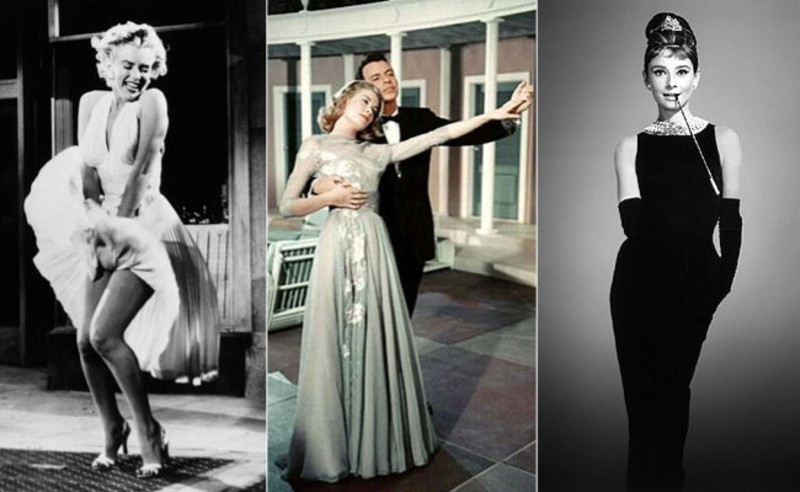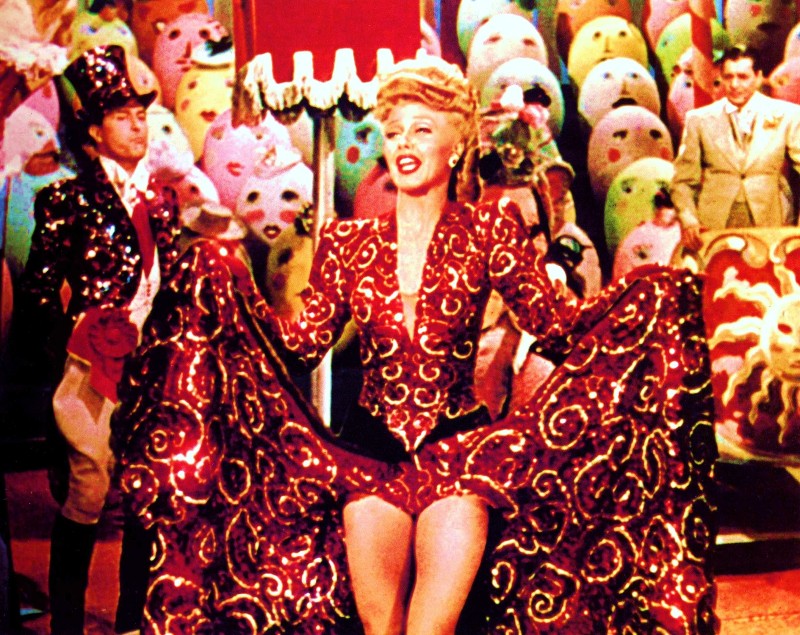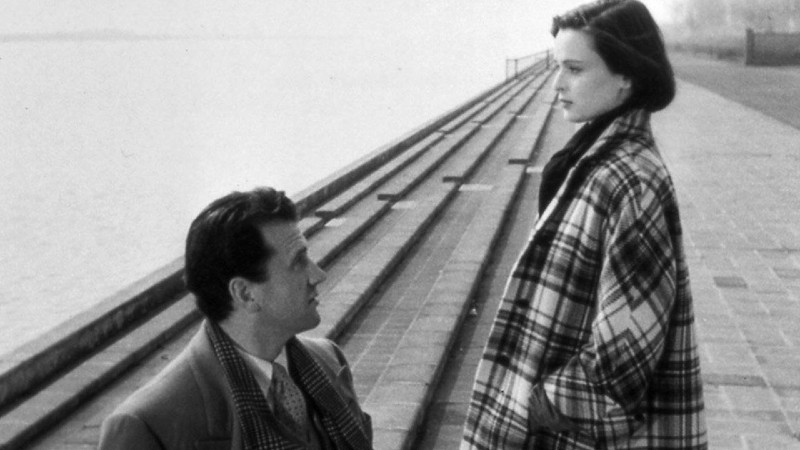Fashion and Cinema

Only about twenty successful movies focus specifically on fashion. Naturally, most of them were made in Hollywood though the Italian cinema was quick to follow. Curiously, only one such film has been made in France. The list begins with Sinners in the Sun (1932, directed by Alexander Hall, starring Carole Lombard, Chester Morris, and Cary Grant).
An impoverished young couple, working at a fashion house
An impoverished young couple, working at a fashion house, joins the rich members of an elegant area of California. Both partners have superficial love affairs. She (Lombard) dreams of wearing the fabulous gowns made in the atelier. At the end of the story, the comedy — true to the traditions of the time — has a happy ending with a moral: “money is not everything.” Cary Grant had a small role. Two years later, it was followed by Fashion of 1934 (1934, directed by William Dieterle, starring William Powell and Bette Davis). Two Americans in Paris, the conman Powell and the fashion designer Davis, plan to steal the patterns from a large atelier. He masquerades as a designer. They succeed in conquering the Parisian fashion world. A comedy with an impressive cast and splendid musical numbers (in particular Spin a Little Web of Dreams) by Busby Berkeley.

The turn of Roberta
Afterwards it was the turn of Roberta (1935, director William A. Seiter, starring Irene Dunne, Fred Astaire, Ginger Rogers, and Randolph Scott). Fleeing from the October Revolution, a Russian princess goes to Paris, becomes a fashion designer and her employer falls in love with her. Originally a theater musical, this romantic story in RKO style became famous for its songs (I Won’t Dance, Smoke Gets in Your Eyes) and the exuberant dance numbers of Ginger Rogers and Fred Astaire, who were relegated to supporting roles. The first Italian film on the theme was La contessa di Parma (1937, director Alessandro Blasetti, starring Elisa Cegani, Antonio Centa, Maria Denis, Umberto Melnati, Osvaldo Valenti, and Nunzio Filogamo). An equivocal, ironic, and sophisticated story, with sequences filmed from real life in the world of haute couture in Turin.
fall in love with the model Marcella
The strikers in the national football team fall in love with the model Marcella — nicknamed the Countess of Parma for her aristocratic bearing. According to Paolo Mereghetti’s film dictionary, it is a “tasteful comedy, situated in the emerging high society of the period” (fashion rather than football) but which Blasetti defined as “the silliest film” he had ever made.” During the same year, in Hollywood, Vogues of 1938 was released (1937, director Irving Cummings, starring Joan Bennet, Warner Baxter, and Misha Auer). A minor musical in Technicolor, based on the rivalry between two fashion houses on Fifth Avenue. The whims of the wife of one of the owners causes a crisis for the business. A model with initiative is able to resolve the situation. More than a true story, Cummings directed runway shows and accompanied them with some great songs, such as That Old Feeling. Artists and Models Abroad appeared a year later (1938, director Mitchell Leisen, starring Jack Benny, Joan Bennet, and Mary Boland): it tells the story of a troupe of female musicians and their manager, in difficulties in Paris. Luckily, the troupe is kindly helped by a Texan oil tycoon. A pleasant comedy, if not particularly original, distinguished from others of the time by its emphasis on elegance and fashion.
the Lady in the Dark was released in the USA
During the middle of the war, the Lady in the Dark was released in the USA (1944, director Mitchell Leisen, starring Ginger Rogers, Ray Milland, Warner Baxter, and Misha Auer). Fashion and psychoanalysis. Wooed by three suitors, the director of the magazine Allure (whose staff wear the most eccentric hats and garments) has problems with her subconscious. She goes to a psychoanalyst and has liberating dreams in Technicolor. In the end, not only does she gain self-assurance but also the right man. Based on a Broadway show, it was a typical romantic comedy of the 1940s: rich, stylized, often amusing. The music was by Kurt Weill and Ira Gershwin. Laura was also released during the war (1944, director Otto Preminger, starring Gene Tierney, Dana Andrews, Clifton Webb, and Vincent Price). It is an archetypal film noir, dense with ambiguity, mystery and necrophilia. While investigating a murder, a police officer falls in love with a portrait of the dead woman, Laura, the director of an advertising agency.
The woman reappears in flesh and blood:
The woman reappears in flesh and blood: it is discovered that the victim was actually an unknown model. It followed the best traditions of the genre, with Gene Tierney more beautiful and fascinating than ever in the elegant clothes of a (supposedly) femme fatale. At the same time, the French Falbalas was released (1944, director Jacques Becker, starring Micheline Presle, and Gabrielle Dorziat). It was the first film made by Becker after the Liberation, a rare example of a European comedy, both sentimental and ironic, set in the Parisian fashion world. It also contained personal memories linked with the director’s adolescence, when his mother worked in haute couture. It was followed by a famous Italian film: Cronaca di un amore (1950, directed by Michelangelo Antonioni, starring Lucia Bosé, Massimo Girotti, and Franco Fabrizi).
Married to a rich industrialist, Paola meets Giulio, the love of her life.
Married to a rich industrialist, Paola meets Giulio, the love of her life. The two become lovers and plan to dispose of her husband. It was Antonioni’s first full-length movie and introduced a (black) picture of Milanese bourgeoisie in the popular climate of Neo-realism. Bosé was splendid, both in the luxurious outfits designed by the very young Fausto Sarli and the immediately legendary undergarments. Some of the sequences were filmed in the salon of Noberasco’s atelier, in Via Manzoni. From Hollywood came a remake, Lovely to Look At (1952, by Mervyn Le Roy, starring Red Skelton, Ann Miller, and Kathryn Grayson). Then came the second version, with important variations, of Roberta: three friends from Broadway go to Paris, where one of them has inherited a fashion house. After having discovered that it is riddled with debt, they rescue it with a gala runway show with a musical accompaniment (the fashion show sequences were directed by Vincent Minnelli). The famous songs of the original were used again, but this time Red Skelton took the lead role.
That same year, Le ragazze di Piazza di Spagna was released in Italy
The same year, Le ragazze di Piazza di Spagna was released in Italy (1952, by Luciano Emmer, with Lucia Bosé, Cosetta Greco, Liliana Bonfatti, Eduardo De Filippo, and Marcello Mastroianni). The story of three young seamstresses working in a Roman atelier, narrated by Emmer in an everyday style and veined with irony. In particular, one of them (Bosé) has the opportunity to become a model but gives it up to marry a worker. The three stories in the film — one of the prototypes of the so-called “pink Neo-realism” — are “narrated” by the writer, Giorgio Bassani. Another Italian film, the winner of the Silver Lion at the Venice Film Festival, was Le amiche (1955, by Michelangelo Antonioni, with Eleonora Rossi Drago, Valentina Cortese, Yvonne Fourneaux, Gabriele Ferzetti, Franco Fabrizi, Madeleine Fisher, and Ettore Manni). Taken from the story by Cesare Pavese, Tre donne sole, Clelia, the director of a fashion house, arrives in Turin to open a boutique. She associates with rich members of the bourgeoisie, models, and intellectuals; one of the group is a girl who attempts to commit suicide. With a screenplay by women (Suso Cecchi D’Amico and Alba de Cèspedes), the film is a bitter drama where the clothes (from the atelier of the Fontana sisters) contribute to the psychological make-up of the characters.
Funny Face dates from 1957
Funny Face dates from 1957 (by Stanley Donen, with Audrey Hepburn, and Fred Astaire). A mature photographer discovers a young model with an unusual face and graceful bearing. He launches her on the world of fashion, falls in love, and she returns his feelings. A musical of great delicacy, elegance and style set in all the typical Parisian locations. Richard Avedon, who at the time worked for Vogue and Harper’s Bazaar, supervised the images: the result is one of the most faithful films ever made on the world of haute couture. Dressed by Givenchy, Audrey Hepburn combined sophisticated grace with a natural sympathy in an unforgettable performance. Another Italian film is Sei donne per l’assassino (1964, by Mario Bava, starring Eva Bartok, and Cameron Mitchell). It is a film ahead of its time: the story of a serial killer set in the fashion world (see later Sotto il vestito niente and its successors).

The proprietor and director of an elegant atelier kill a model in order to cover up a previous crime
The proprietor and director of an elegant atelier kill a model in order to cover up a previous crime. This sets off a series of other murders. Baroque and sadistic, the film was condemned as immoral at the time. Prêt-à-porter (1994, by Robert Altman, with Julia Roberts, Sofia Loren, Marcello Mastroianni, Kim Basinger, Anouk Aimée, Lauren Bacall, and Rupert Everett). During the prêt-à-porter week, Paris is teeming with fashion designers, models, journalists, photographers, and VIPs. In the middle of it all, there is a murder. Critical as ever, Altman uses fashion as a metaphor for a society of appearances, where beautiful clothes hide a void. The designer Aimée makes a stand against consumerism by organizing a show with nude models. A small army of stars appeared in the film for the American director, among them the former models Kim Basinger and Lauren Bacall, as well as real designers (Ferré, Trussardi, Gaultier) playing themselves.
Unzipped
Unzipped (1995, by Douglas Keeve, with Isaac Mizrahi, Cindy Crawford, and Linda Evangelista). This was an American documentary on the runway shows of the designer Isaac Mizrahi. Mixing film and video, color and black-and-white, the director alternates official runway footage with shots of the models behind stage. Some of the most famous models appeared as themselves — Cindy Crawford, Naomi Campbell, Kate Moss, Linda Evangelista — complaining of their sore feet and voicing their whims. In the 1990s, the soap opera Beautiful appeared, first in the United States and then across Europe. Numerous love intrigues are played out against the background of two competing fashion houses.
READ ALSO:
Cinema e moda si uniscono nel nome di Jean-Paul Gaultier

